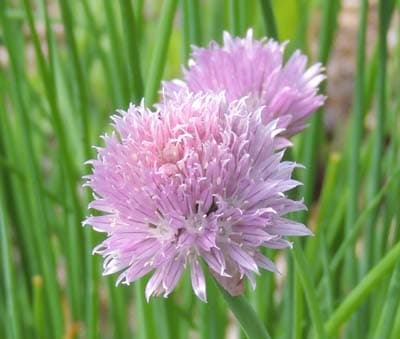How to Grow Ornamental Allium Flowers

About Growing Allium Plants in Your Home Flower Garden
There are several hundred species of Allium plants. Perennial Ornamental Alliums are members of the onion family. Among the best known Alliums are chives, onions, garlic, and shallots. For the flower gardener, there are many varieties of Flowering Allium, also called “Flowering Onion”. Growing alliums is a cinch. They are often found in natural settings growing without assistance. They spread readily and pretty much take care of themselves.
This hardy, easy-to-grow flowering bulb comes in a wide variety of colors, heights, and blooming times. Big, multi-floret, round blooms are produced atop of a tall, sturdy spike. In general, they bloom from late spring to early summer. Once established in your flower garden, they will likely grow for many, many years with little attention.
Use dried Ornamental Allium in a variety of decorating and artistic applications.
As an ornamental, the largest, giant varieties are the most sought after. They are also known as Allium Giganteum.
Ornamental Allium Flowers Plant Specifications
Flower colors: Colors include Green, pink, purple, yellow, and white.
Flowers Bloom: Early Spring. Also, there are fall-blooming varieties.
Plant Height: 4 – 10 feet tall, depending upon variety.
Ideal Soil pH: 5.5 – 6.5.
Are Plants Toxic? Mildly toxic to humans, pets, and farm animals.
Deer Resistant? Yes, the plants are resistant to deer and rabbits.
Native To: Middle Eastern countries.
Plant Type: Perennial.
Botanical Name: Allium

Are Ornamental Allium Flowers and Plants Edible?
NO!!
This is an important difference between different types of alliums. Alliums like chives, garlic, onions, and shallots are edible and tasty. On the other hand, ornamental alliums are not edible. Consuming them poses potential health risks. And, allegedly, they are not tasty anyways.
Medicinal Uses for Ornamental Allium Flowers
Alliums have several medicinal applications. However, our research has not been able to specifically identify Ornamental Alliums as being among this group. Because Ornamental Alliums have toxic properties, we recommend you do not use this plant for medicinal purposes or home medical remedies.
Sunlight Needs
Ornamental Allium plants grow and bloom their best in full sunlight. Plant them in a location where the receive at least six to eight hours of bright, direct sunlight.
These plants also grow in partial shade. However, too little sun can result in less sturdy flower stems that are more susceptible to falling over in strong winds.
Allium Plant Propagation
Ornamental Onions, or perennial Alliums, are grown from bulbs. The flower head also produces seeds, but most gardeners plant easy-to-handle bulbs.
Plant Allium bulbs in the soil in the spring, as soon as the ground can be worked. Plant them to a depth of twice the diameter of the bulb.
If planting Allium seeds, sow them directly into the garden, planting just 1/8″ deep.
Days to Germination: 10 – 14 days.
How to Grow Allium Flower Plants
Growing Ornamental Alliums is very easy to grow. They like full sun to partial shade.
The plants tolerate poor soils but prefer the soil to be well-drained. Adding a general-purpose fertilizer once in early spring will give them a boost on the season.
They are a low maintenance plant. Once your Ornamental Allium plants are established, they should grow well with few problems.
The roots do not like extended periods of wet, soggy soil. Keep the soil moist to slightly dry. Water them during dry periods, once or twice per week.
Keep the plants well weeded, especially when they are young. And apply a 2-to-3-inch layer of mulch around the plants, for a tidy appearance.
Perennial Ornamental Allium plants have long lives. They will come back yearly for many years.
plant disease can occur during extended periods of hot and humid or rainy weather. Thin the clump of plants to allow better air circulation.
You may need to support the flower stems. This is especially true when the plants are grown in partial shade, resulting in thinner, less sturdy flower stems.
Allium plants become overcrowded after several years. Dig up the bulbs and separate them. Then, re-plant the bulbs. And, give some bulbs to gardening friends!
Did You Know? Ornamental Alliums are good cut flowers. But, they give off a slight onion scent… no surprise there!
Pruning Ornamental Allium Plants
During the growing season, the plants need no pruning. After the flowers have died, remove the flower stem from the plant. This directs the plants energy to be stored in the bulb for next year’s growth and blooms.
Insects and Plant Disease
Allium plants have few insect or disease problems.
Root rot can occur in wet soil.
Also see: Plant Problems – Identify the causes and find the cures.
Overwintering Ornamental Allium Flowers
Ornamental Allium are hardy plants. At the end of the season, cut the plants back to the ground. Your plants are now ready to regrow as soon as the soil begins to warm in the spring.
Related Articles
Please support our site. Shop for:
- rmmatthews100@hotmail.com
- 585-721-6528
- Rochester, NY
©1999-2024 GardenersNet.Com, All Rights Reserved

